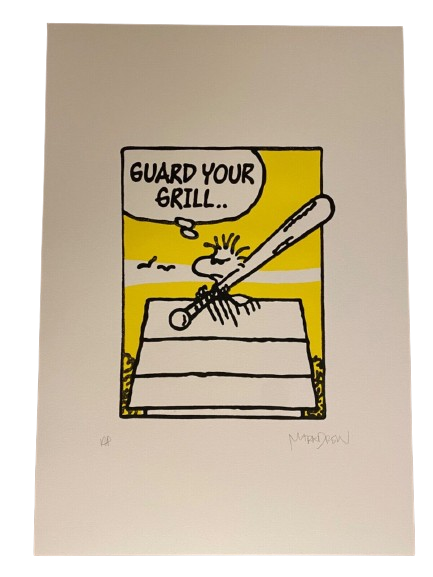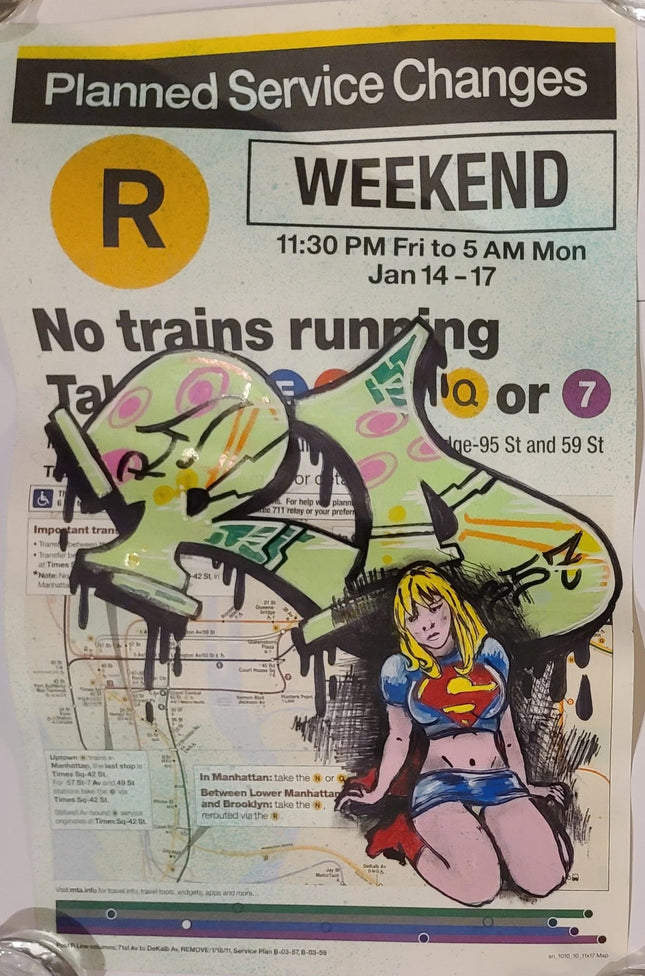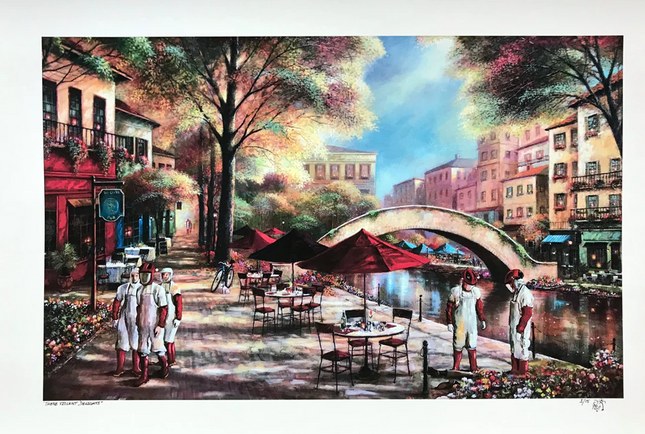
TV Television

Mark Drew Guard Your Grill Naughty by Nature AP Silkscreen Print by Mark Drew
Guard Your Grill Naughty by Nature A.P. Silkscreen Print by Mark Drew Artist Proof Hand-Pulled Screen Print on Fine Art Paper Limited Edition Pop Street Artwork & Graffiti. A.P. Artist Proof 2018 Signed & A.P. Marked Limited Edition Run Artwork Size 11.73.x16.5 Exploring Urban Narratives in Mark Drew's Screen Print "Guard Your Grill Naughty by Nature" is a compelling silkscreen print by artist Mark Drew, encapsulating street culture's raw energy and ethos. As an Artist Proof from 2018, this hand-pulled screen print on fine art paper signifies a limited edition run that captures the essence of the crossover between street art, graffiti, and pop culture. The artwork, sized 11.73 x 16.5 inches, is marked with the artist's signature and the distinctive A.P., asserting its status as a rare and valuable proof within the edition. This piece is a testament to Drew's mastery in combining textual and visual narratives to create a piece that is as evocative as it is aesthetically striking. The print's title, "Guard Your Grill," references a song by the hip-hop group Naughty by Nature, suggesting a theme of vigilance and resilience. Drew's work often delves into the lexicon of hip-hop, bringing its language into a visual format that resonates with a broad audience. Combining these lyrics with imagery reminiscent of classic comic strips indicates the artist's signature approach to Street Pop Art and Graffiti Artwork, where he bridges generational and cultural gaps to offer commentary on contemporary society. Mark Drew's Artistic Process and Cultural Impact Mark Drew's artistic process involves carefully balancing handcrafted techniques and thematic street and pop culture exploration. The screen printing process, a favorite among street and pop artists for its ability to produce vibrant, clean lines, allows Drew to create modern and timeless works. The Artist Proof designation of "Guard Your Grill" underscores the meticulous nature of Drew's practice; these proofs are typically pulled before the main edition to ensure the quality of the print, and often, they are kept by the artists themselves or sold as highly collectible items. Drew's integration of hip-hop lyricism into his work does more than pay homage to the genre; it serves as a medium for cultural commentary. By selecting phrases from hip-hop culture and integrating them into visual motifs from mid-20th-century comics, Drew fosters a dialogue between past and present, highbrow and lowbrow, and the mainstream and the marginal. This dialogue is a defining characteristic of Street Pop Art, where the interplay of different cultural elements can lead to a deeper understanding of the issues at hand. The cultural impact of Drew's work is significant. By immortalizing hip-hop's language within the framework of visual art, Drew preserves and honors the music genre's cultural significance while expanding the conversation around it. His pieces, including "Guard Your Grill," function as cultural artifacts that capture the spirit of their time while providing a lens through which future generations can understand the historical context of the 90s hip-hop movement. Drew continues to contribute to the rich tapestry of Street Pop Art and Graffiti through his art, ensuring its relevance and accessibility to a diverse and global audience.
$1,500.00

RD-357 Real Deal Supergirl No Trains Running Original Acrylic Spray Paint Painting by RD-357 Real Deal
Supergirl- No Trains Running Original One of a Kind Mixed Media Spray Paint Acrylic Painting Artwork on New York Subway Notice by Popular Street Graffiti Artist RD-357. Painting of DC Comics Femail Superhero Supergirl on a real New York/Manhattan Subway Notice. Planned Service Changes, No Trains Running, Jan 14-17 2011
$613.00$521.00

Dave Pollot These Violent Delights Giclee Print by Dave Pollot
These Violent Delights Giclee Print by Dave Pollot Artwork Limited Edition Print on Fine Art Paper Graffiti Pop Street Artist. 2020 Signed & Numbered Limited Edition of 15 Artwork Size 24x16.5 Vinatge Italian City on Riverway Populated By Workers From Westworld TV Show Dave Pollot's "Old Is New Is Old Again" is a compelling piece of limited edition giclee print artwork that has found its grounding in the intersection of pop art, street art, and graffiti art. Released in 2020, this stunning piece is a testament to Pollot's unparalleled ability to repurpose, reimagine, and recontextualize traditional art forms into contemporary and engaging works. As part of an exclusive series, only 10 signed and numbered copies of this masterpiece exist, each meticulously produced on fine art paper to ensure longevity and vibrancy of color. Measuring 8x10 inches, with a mat that extends the dimensions to 11x14 inches, "Old Is New Is Old Again" is a captivating representation of a Renaissance man in vintage attire. The main subject, distinguished and posed as a gentleman of a bygone era, sports a curious addition that beautifully exemplifies Pollot's creative aesthetic — a graphic of a wolf howling at the moon. This piece seamlessly integrates aspects of modern imagery with classical portraiture, resulting in a unique fusion that embodies the spirit of graffiti pop and street art. In the realm of pop art, Pollot's piece is a nod to the repetition and mass production synonymous with the movement. By embedding modern iconography into a traditional portrait, the artist creatively merges past and present, thereby urging viewers to explore the ubiquitous influence of pop culture on societal perception. The wolf, a symbol often found in street and graffiti art, adds an element of rawness and organic spirit to the otherwise refined and polished depiction of the gentleman. Street art, often reflective of social and cultural expressions, finds its representation in the artwork as well. Pollot's rendering of the gentleman is symbolic of the adaptability and fluidity of street art, with its roots firmly set in the culture of the streets but its reach extending far beyond. The unorthodox incorporation of a graffiti-style wolf into a classical portrait suggests a strong link to street culture, bridging the gap between fine art and popular expressions of creativity. Graffiti art, traditionally associated with rebellion and counterculture, takes on a new form in "Old Is New Is Old Again." The howling wolf, often used in graffiti as a signifier of freedom and independence, has been seamlessly incorporated into the artwork. Its presence offers a stark contrast to the gentleman's attire, suggesting a dichotomy between societal norms and the desire for personal freedom and expression. Through this piece, Dave Pollot has remarkably bridged the gap between varying art forms and historical periods, crafting a timeless piece that speaks volumes of his understanding of art and culture. "Old Is New Is Old Again" is a perfect example of Pollot's ability to draw from diverse artistic movements and social themes, creating a work that resonates with the complexity and diversity of the human experience. In essence, this piece serves as a visual dialogue between different eras and artistic styles, proving that in the realm of art, the old and the new can coexist in the most harmonious and visually striking ways.
$480.00




